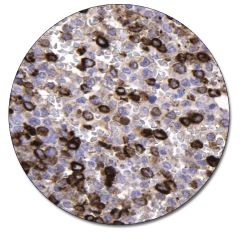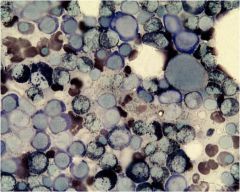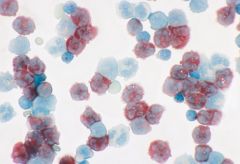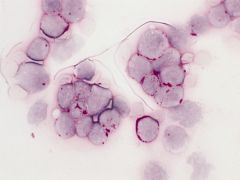![]()
![]()
![]()
Use LEFT and RIGHT arrow keys to navigate between flashcards;
Use UP and DOWN arrow keys to flip the card;
H to show hint;
A reads text to speech;
64 Cards in this Set
- Front
- Back
|
FAB Classification vs WHO Classification |
FAB - morphology - cytochemistry WHO - clinical features & morphology - immunophenotyping - genetic features |
|
|
Clinical Findings - Leukemias |
anemia thrombocytopenia (bleeding) neutropenia (infections) or neutrophilia bone pain (expansion of marrow) weight loss hepato/spleno/lymphadenopathy rashes, tumors, CNS involvement |
|
|
Acute vs Chronic Leukemias - key differences |
ACUTE > 20-30% blasts arrested maturation/hiatus development ↓ to ↑ WBCs, N to ↓Plt CHRONIC < 20% blasts normal maturation (uncontrolled) ↑ to ↑↑↑ WBCs, N to ↑ Plts |
|
|
MPO cytochemical stain |

Myeloperoxidase Differs AML from ALL granule peroxidases oxidizes dye substrate to black/brown precipitate CONSIDER BLASTS ONLY! Positive = >5% cells w/ precipitate Positive = AML |
|
|
SBB cytochemical stain |

Sudan Black B
Differs AML from ALL stains lipids found in granules of neutrophils and monos to black CONSIDER BLASTS ONLY! Positive = >5% cells w/ black Positive = AML |
|
|
Specific Esterase cytochemical stain results |

Specific Esterase Differs btw myelo and mono CONSIDER BLASTS ONLY!Positive = >5% cells w/ red Positive = AML - myelocytic |
|
|
Specific Esterase cytochemical stain principle
|
Specific Esterase
Used to differentiate myelos from monos Myelos stain red napthol AS-D chloroacetate hydrolyzes substrate, releasing napthol compound that combines w/ a diazonium salt that precipitates red |
|
|
Non-Specific Esterase cytochemical stain results
|

Non-Specific Esterase Differs myelo from mono Monos - strong positive Myelos can be weak positive CONSIDER BLASTS ONLY! Positive = >5% cells w/ black Positive = AML - monocytic |
|
|
Non-Specific Esterase stain principle
|
Non-Specific Esterase
Used to differentiate myelos from monos Monos stain black (strong positive) alpha napthyl acetate hydrolyzes substrate, releasing napthol compound that combines w/ a diazonium salt that precipitates black |
|
|
Non-Specific Esterase cytochemical stain
results w/ NaF |
Used to confirm Non-Specific Esterase if weakly positive - NaF inhibits the rxn in monocytes Interpretation NSE is weak pos/NaF weak pos = myelo NSE is weak pos/NaF neg = mono |
|
|
Remember! |
Cytochemicals stain mature cells too! You're only looking at the percentage of stained blasts! |
|
|
PAS cytochemical Stain results |

Periodic Acid Schiff Differs lymphs and erythros from myelo/monoblasts CONSIDER BLASTS ONLY! Coarse pink only! Not diffuse Positive = >5% cells coarse pink Positive = malignant lymph, rbc, megakaryoblasts will be diffuse |
|
|
PAS cytochemical Stain principle
|
Periodic Acid Schiff (PAS) Periodic acid oxidizes glycogen and other HMW carbs to aldehydes that react w/ Schiff reagent to stain bright pink pos = coarse pink only - not diffuse pos = malignant lymps, RBCs or megakaryos |
|
|
LAP cytochemical stain principle |
Leukocyte Alkaline Phosphatase (LAP) Used to differ btw leukemia & leukamoid rxn. LAP enzyme found in secondary granules of PMNs hydrolyzes substrate (napthol-AS-BI phosphate), and forms red precipitate. Interpretation - 100 cells scored 0-4 Normal = 15-70 L Rxn = 150-365, CML = 0-24 CML of childhood = high |
|
|
LAP cytochemical stain results |

Leukocyte ALP
Differs leukamoid rxn from CML 100 PMNs graded (black precipitate) N = 15-70 Leukamoid Rxn = 150-365 CML = 0-24 CML of childhood = high LAP |
|
|
TRAP cytochemical stain principle |
Tartrate Resistant Acid Phosphatase (TRAP) Acid Phos present in almost all nonerythroid cells hydrolyzes substrate (napthol AS-BI phosphate), and forms red precipitate. Treatment with Tartaric Acid inactivates normal acid phosphatases. Hairy cell isoforms of acid phosphatase are not inactivated and stain red.pos (red) = Hairy cells |
|
|
TdT immunofluorescent stain |

Terminal Deoxyribonucleotidal Transferase (TdT)
cell marker of lymph precursors only - immunoperoxidase or immunofluorescent techniques pos = ALL - L1 and L2 (some AML) |
|
|
AML M0 |
M0 - Acute Myeloblastic Leukemia w/o Cytological Maturation >30% non-committed blasts ALL STAINS NEG 5% adult AMLs, poor prognosis |
|
|
Remember! |
Until the marrow is entirely replaced by the malignant population, normal cells will continue to mature and be present alongside the blast/abnormal population. |
|
|
AML M1 |
M1 - Acute Myeloblastic Leukemia
w/o Maturation >30% myeloblasts MPO/SBB +, SE +, NSE +/=, NaF +/=, PAS = possible auer rods, ↑ WBC, ↓Plt 15% AMLs (adults and neonates), aggressive |
|
|
AML M2 |
M2 - Acute Myeloblastic Leukemia w/ Maturation >30% myeloblasts - pros and beyond MPO/SBB +, SE +, NSE +/=, NaF +/=, PAS = possible auer rods, ↑ WBC, ↓Plt 25% of adult AMLs, may be blast crisis of CML |
|
|
APL M3 |
M3 - Acute Promyelocytic Leukemia >30% myeloblasts & pros (heavy granulation) MPO/SBB +, SE +, NSE +/-, NaF +/=, PAS = frequent auer rods, ↑ WBC, ↓Plt usually an adult AMLs, DIC possible complication of treatment |
|
|
APL M3m |
M3m - Microgranular Varient of APL >30% myeloblasts & pros (no granulation) MPO/SBB +, SE +, NSE +/=, NaF +/=, PAS = some abnormal nuclear shapes frequent auer rods, ↑ WBC, ↓Plt may be mistaken for AML or AMoL |
|
|
AMML M4 |
M4 - Acute Myelomonocytic Leukemia >30% myeloblasts & monoblasts MPO/SBB +, SE +, NSE +/-, NaF +/=, PAS = possible auer rods, ↑ WBC, ↓Plt 20% of adult AMLs, can invade skin, gums, etc. |
|
|
AMML M4Eo |
M4Eo - Acute Myelomonocytic Leukemia w/ Eosinophilia >30% myeloblasts/monoblasts & marrow eos MPO/SBB +, SE +, NSE +/-, NaF +/=, PAS = possible auer rods, ↑ WBC, ↓Plt |
|
|
AMoL M5a |
M5a - Acute Monocytic Leukemia poorly differentiated >30% monoblasts MPO/SBB +, SE =, NSE +++, NaF =, PAS = rare auer rods, ↑ to ↑↑↑ WBC, ↓Plt usually kids/young adults, can invade tissues |
|
|
AMoL M5b |
M5b - Acute Monocytic Leukemia differentiated >30% monoblasts w/ lots of pros and monos MPO/SBB +, SE =, NSE +++, NaF =, PAS = rare auer rods, ↑ WBC, ↓Plt usually kids/young adults, can invade tissues |
|
|
AEL M6a |
M6a - Acute Erythrocytic Leukemia (DiGuglielmo) >50% rbc precursors & >20% myeloblasts MPO/SBB =, SE =, NSE =, NaF =, PAS + many/bizarre Plt, BM erythroidhyperplasia often ↑MCV and anemia looks like left shift w/ lots of nrbcs |
|
|
AEL M6b |
M6b - Acute Erythrocytic Leukemia (DiGuglielmo) >80% nrbcs of marrow cellularity/no myelo MPO/SBB =, SE =, NSE =, NaF =, PAS + many/bizarre Plt, BM erythroidhyperplasia often ↑MCV and anemia looks like left shift w/ lots of nrbcs |
|
|
AML M7 |
M7 - Acute Megakaryocytic Leukemia >30% megakaryoblasts in marrow MPO/SBB =, SE =, NSE =, NaF =, PAS + bizarre Plt possible rarest AML, associated w/ myelofibrosis (dry tap possible) |
|
|
ALL L1 |
L1 - Acute Lymphocytic Leukemia small lymphoblasts (clefting, scanty cytoplasm, uniform pop.) MPO/SBB =, SE =, NSE =, NaF =, PAS +, TdT + ↓ Plt and WBC (sometimes WBC very high) CNS infiltration common |
|
|
ALL L2 |
L2 - Acute Lymphocytic Leukemia large lymphoblasts (irregular nuc, often moderate cytoplasm, heterogeneous population) MPO/SBB =, SE =, NSE =, NaF =, PAS +, TdT + ↓ Plt and WBC (sometimes WBC very high) CNS infiltration common |
|
|
ALL L3 |
L3 - Acute Lymphocytic Leukemia
leukemic conversion of Burkitt's lymphoma large blasts w/ very basophilic cytoplasm punch-out vacuoles MPO/SBB =, SE =, NSE =, NaF =, PAS +, TdT = |
|
|
Common characteristics of Myeloproliferative Disorders (includes CMLs) |
panhyperplasia in BM extramedullary hematapoiesis BM fibrosis frequent termination in acute leukemia increased megakaryos in BM (often abnormal) Plt dysfunction cytogenic abnormalities |
|
|
Chronic Myelogenous Leukemia (CML) |
Chronic Myelogenous Leukemia (CML) ↑↑↑ WBC (blood resembles BM) - mature & immature w/ <10% blasts looks like left shift w/ LOW LAP hypercellular marrow (10-50:1) possible pseudo Pelger-Huets & Gauchers usually age 45+, abn Ph22, can transform to M2 & other AMLs eos and baso varients (rare, aggressive, poor prognosis) |
|
|
Chronic Neutrophilic leukemia |
Chronic Neutrophilic leukemia
↑↑↑ WBC, ↓ Plt persistent ↑ PMNs w/o left shift/sepsis HIGH LAP possible toxic granules and dohle bodies |
|
|
Chronic Monocytic Leukemia |
Chronic Monocytic Leukemia
very rare no longer WHO classified |
|
|
Polycythemias (Myeloproliferative Disorder) |
Increased RBCs Polycythemia Vera: malignancy (↑ LAP) 2° Polycythemia: non-pathological compensation for low 02 (LAP normal) Relative Erythrocytosis: same number of RBCs w/ low plasma volume (LAP normal, ↑ Hct) |
|
|
Polycythemia Vera (Myeloproliferative Disorder) |
Polycythemia Vera - malignant increase in red cell mass ↑ LAP, ↑ WBCs & Plts, normal O2 Sat extramedullary hematapoisis BM hypercellullar (erythro/myelo/megakaryo) disease progression leads to ↑ aniso/poik (tear drops), Fe deficiciency JAK2 gene mutation |
|
|
Essential Thrombocythemia (Myeloproliferative Disorder) |
Essential Thrombocythemia
↑↑↑ Plt, spontaneous Plt aggregation/dysfn giant bizarre Plts, megakaryo fragments ↑ WBC w/o left shift (neutrophilia) thrombocytic & hemorrhagic complications 30-50% JAK2 mutation |
|
|
Remember! |
A shift to the left/leukamoid reaction is not just increased WBCs Left shift is increased immature WBCs Neutrophilia is just an increase in WBCs |
|
|
Chronic Ideopathic Myelofibrosis (Myeloproliferative Disorder) |
Chronic Ideopathic Myelofibrosis
↑ immature WBCs & nRBCs in blood tear drops, abn megakaryos, ↑Plt Poss Plt agranular, micro, impaired aggreg extramedullary hematapoiesis (crowding) marrow fibrosis, anemia JAK2 mutation |
|
|
Myelodysplastic Syndromes |
Myelodysplastic Syndromes
- diverse diseases (mild anemia to preleukemias) - common chromosomal defects: del 5q, monosomy 7, trisomy 8, deletions in 11, 12, and 20 - median age 70 years |
|
|
Myelodysplastic Syndromes - Dyserythropoiesis
|
Myelodysplastic Syndromes
Dyserythropoiesis any weird RBC morphology oval macrocytes, asynchronism, baso stippling sideroblasts, ringed sideroblasts, pappenheimer ineffective hematapoiesis/increased apoptosis |
|
|
Myelodysplastic Syndromes - Dysmyelopoiesis
|
Myelodysplastic Syndromes
Dysmyelopoiesis usually neutropenia, hypogranulation usually hyposegmentation (pseudo P-H) asynch. (basophilic zones - pseudo dohle) cell mixes of eos/baso hybrid myelomonocytes |
|
|
Myelodysplastic Syndromes -
Dysmegakaryopoiesis |
Myelodysplastic Syndromes
Dysmegakaryopoiesis usually thrombocytopenia micromegakaryocytes hypo or hypersegmentation hypo or agranular giant Plts |
|
|
Refractory Anemia (RA) and (RARS) (Myelodysplastic Syndrome) |
Refractory Anemia
Blood: anemia, ↓ WBC & Plt, no/rare blasts BM: erythroid dysplasia only, ↑ Fe stores < 5% blasts RA: < 15% ringed sideroblasts RARS > 15% ringed sideroblasts |
|
|
Refractory Cytopenia w/ Multilineage Dysplasia (RCMD) and (RCMD-RS)
(Myelodysplastic Syndrome) |
Refractory Cytopenia
w/ Multilineage Dysplasia (RCMD) Blood: bi or pancytopenia, no/rare blasts, no monos/auer rods BM: > 10% dysplasia of eryrthroid & 1 or more other myeloid types < 5% blasts, no auer rods RCMD: < 15% ringed sideroblasts RCMD-RS > 15% ringed sideroblasts |
|
|
Refractory Anemia w/ Excess Blasts
(RAEB-1 &2) (Myelodysplastic Syndrome) |
Refractory Anemia w/ Excess Blasts
(RAEB-1 &2) Blood: cytopenias, no monos/auers RAEB-1: < 5% blasts, RAEB-2: 5-9% blasts BM: uni or multilineage dysplasia RAEB-1: 5-9% blasts, RAEB-2 10-19% blasts |
|
|
Unclassified MDS |
Unclassified MDS Blood: cytopenia, no/rare blasts BM: myelo or megakaryodysplasia NO ERYTHRODYSPLASIA < 5% blasts |
|
|
Chronic Myelomonocytic Leukemia (Myelodysplastic/Myeloproliferative Disease) |
Chronic Myelomonocytic Leukemia
typical dyspoiesis of MDS increased WBCs (monos, promonos, granulos, immature granulos) < 20% blasts |
|
|
CLL/SLL |
Chronic/Small Lymphocytic Leukemia SLL: involves lymph nodes & lymph organs CLL: blood & BM lymphocytosis - most common chronic leukemia - usually older adults - 95% are B cell |
|
|
CLL/SLL lab findings |
CLL/SLL variable WBC predominance of small mature lymphs many smudge cells suppression of all Ig - infection slow marrow infiltration can develop autoimmune disease PAS + |
|
|
Hairy Cell Leukemia |
Hairy Cell Leukemia
lymph w/ mono features PAS =, SBB +, NSE +, TRAP + phagocytic, produce Ig splenomegaly, pancytopenia often low WBC, dry tap |
|
|
Hodgkin's Lymphoma |
Hodgkin's Lymphoma malignant clone - usually B cells Reed-Sternberg cell: large bi/multi nuc (red) w/ clear zone (owl eyes) Hodgkin cell: mononuclear version cells are usually few in number |
|
|
Non-Hodgkin's Lymphoma |
Non-Hodgkin's Lymphoma
- lymphocytic malignancy - inciting agents/mutagenic factors: chemicals, radiation, viruses - damage to genetic code regulating immune cell growth and reproduction |
|
|
Cutaneous T cell Lymphoma & Sezary Syndrome |
Cutaneous T cell Lymphoma
- skin lymphoma w/ characteristic lesions Sezary Syndrome - progression of above to blood - Sezary cell: mature lymph w/ convoluted, cerebriform nuclear folds |
|
|
Solitary Plasmacytoma |
Solitary Plasmacytoma (Plasma Cell Disorder)
- malignant clone of plasma cells - localized to one area of bone or soft tissue - most often develops to Multiple Myeloma |
|
|
Multiple Myeloma test results |
Multiple Myeloma (plasma cell Disorder)
- M-spike: monoclonal Ig (usually IgG) diagnose & id w/ SPE & IEP - suppression of normal normal Ig - ↑ ESR & bleeding (abn Ig polymerize and ↑ viscosity/bind Plt) - 25% of MM plasma cells secrete only light chains (renal fail) - plasma cells produce osteoclast activating factor - breaks down bone- increased serum Ca++ and Phosphorous |
|
|
Multiple Myeloma differentials |
Multiple Myeloma (plasma cell Disorder) - few if any plasma cells in blood - can see Russell Bodies, Mott & Flame cells - can see immature plasma cells, abn nuc, loss of halo - rouleaux (abn Ig polymerize/incr viscosity) - suppression of normal plasma cells |
|
|
Plasma Cell Leukemia |
Plasma Cell Leukemia
- terminal acute phase of Multiple Myeloma - plasma cells in blood |
|
|
Waldenstrom's Macroglobulinemia |
Waldenstrom's Macroglobulinemia
- malignant lymphocyte/plasma cell proliferation disorder - monoclonal production of IgM - neurological issues, infections - bleeding (Plt coated w/ IgM, interferes w/ fibrin clot formation) - rouleaux - cryoglobulin (cold-initiated protein precipitation): Raynaud's phenomenon, thrombosis, renal damage |
|
|
Monoclonal Gammopathy of Undetermined Significance |
Monoclonal Gammopathy
of Undetermined Significance - 3% of all adults over 70 years - milder plasmacytosis in BM w/ no other abnormalities - +/- 20% progress to Multiple Myeloma |
|
|
Heavy Chain Disease (HCD) |
Heavy Chain Disease (HCD)
very rare excessive production of heavy chain Ab subunit |

